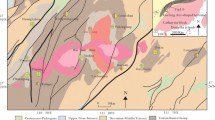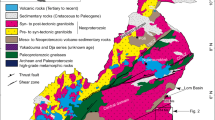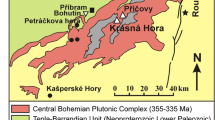Abstract
The Terziali gold mineralization is located within the Central Anatolian Crystalline Complex and represents one of the significant gold occurrences in central Turkey. This gold mineralization is emplaced along the Demirli Thrust Zone striking northwest-southeast with a southwest dip. The hanging wall of this thrust zone consists of Carboniferous metasedimentary rocks, whereas the footwall rocks is dominated by a Permian-aged marble. The metamorphic rocks are intruded by the upper Cretaceous-Paleocene Çayağzı syenite, and the mineralization is mainly hosted by breccia cements and clasts, and fine-grained grayish fracture fill quartz veins. This study reports new geochemical, mineralogical, fluid inclusion, and S stable isotope data from the Terziali gold mineralization in order to better understand its ore genesis. The mineralization is constituted of dravite, quartz, sericite/fuchsite, and carbonate in the proximal alteration zone, whereas the distal alteration zone in the Terziali is characterized by silicification along the thrust contact. The ore mineralogy is mainly composed of disseminated pyrite, Fe-oxides, and lesser amounts of chalcopyrite and arsenopyrite, and minor to trace gold. In relation to the first and second mineralization stages, the Terziali mineralization presents compatible homogenization temperatures (Th °C) range between 336–248 °C and 245–178 °C, and the mineralized fluids were observed over two phases of relatively low salinity and high salinity average: 2.2 and 21.8 wt% NaCl equ. with an average of 10.3 wt% NaCl equivalent, respectively. Further, the sulfur isotope δ34S compositions from the Terziali mineralization range from 5.6 to − 12.1‰ (mean value of − 8.8‰) and indicate the involvement of magmatic and sedimentary sourced solutions. The overall geochemical, mineralogical, and stable isotope data reported here indicate that the Terziali gold mineralization exhibits similar characteristics with shear-related orogenic gold deposits, and this finding can be also indicative for the presence of similar systems in Central Anatolia and the western Tethyan Belt.

modified from Okay and Tüysüz, 1999), B geological map showing plutonic and basement rocks and main structural units of the Central Anatolia region (simplified from 1/25 K geological map of Turkey (MTA) and the coordinates for Fig. 1A in latitude/longitude, Fig. 1B in UTM Zone 36 N) and simplified geological map of the Central Anatolian Crystalline Complex (modified from Aydın et al. 1998) (yellow points describe the location of the Terziali gold mineralization)








taken from Shepherd et al. 1985)


Similar content being viewed by others
References
Akçay M, Özkan HM, Moon CJ, Spiro B (2006) Geology, mineralogy and geochemistry of the gold-bearing stibnite and cinnabar deposits in the Emirli and Halıköy areas (Ödemiş, İzmir, West Turkey). Ore Geol Rev 29(1):19–51
Akıman O, Erler A, Göncüoğlu MC, Güleç N, Geven A, Türeli TK, Kadıoğlu YK et al (1993) Geochemical characteristics of granitoides along the western margin of the Central Anatolian Crystalline Complex and their tectonic implications. Geol J 28(3–4):371–382
Aydın N, Göncüoğlu MC, Erler A (1998) Latest Cretaceous magmatism in the Central Anatolian Crystalline Complex: review of field, petrographic and geochemical features. Turk J Earth Sci 7:259–268
Beyazpiriç M, Akçay AE, Özkan MK, Sönmez MK, Dönmez M, Gürel M (2017) Kalkanlıdağ formasyonu (Geç Devoniyen), Kervansaray formasyonu (Karbonifer-Erken Permiyen), Bozçaldağ formasyonu (Geç Permiyen) MTA Bilimsel Etkinlikler Haftası, 06–10 Mart 2017 (in Turkish).
Bierwirth PN (2008) Laboratory and imaging spectroscopy of tourmaline—a tool for mineral exploration. 14th Australasian Remote Sensing and Photogrammetry Conference, Darwin.
Bodnar RJ (1993) Revised equation and table for determining the freezing point depression of H2O-NaCl solution. Geochem Cosmochim Acta 57:683–884
Bozkurt E, Mittwede SK (2001) Introduction to the geology of Turkey—a synthesis. Int Geol Rev 43(7):578–594
Boztuğ D, Jonckheere RC (2007) Apatite fission-track data from Central Anatolian granitoids (Turkey): constraints on Neo-Tethyan closure. Tectonics 26 (3).
Boztuğ D (1998) Post-collisional Central Anatolian alkaline plutonism, Turkey. Turk J Earth Sci 7:145–165
Chang Z, Large RR, Maslennikov V (2008) Sulfur isotopes in sediment-hosted orogenic gold deposits: evidence for an early timing and a seawater sulfur source. Geology 36(12):971–974
Clarke RN, King TVV, Klejwa M, Swayze GA (1990) High spectral resolution spectroscopy of minerals. J Geophys Res 95: B8,12,653–12,680.
Çimen O, Corcoran L, Kuebler C, Simonetti SS, Simonetti A (2020) Geochemical, stable (O, C and B) and radiogenic (Sr, Nd, Pb) isotopic data from the Eskişehir-Kızılcaören (NW-Anatolia) and the Malatya-Kuluncak (E-Central Anatolia) F-REE-Th deposits, Turkey: implications for nature of carbonate-hosted mineralization. Turkish J Earth Sci 29:798–814
Gençalioğlu Kuşçu G, Kuşçu İ, Göncüoğlu MC (2001) Skarn mineralogy and zoning patterns of Karamadazı (Yahyalı-Kayseri) iron deposit. Geol Bull of Turkey. 44 (3), Ayhan Erler Özel Sayısı.
Goldfarb RJ, Leach DL, Rose SC, Landis GP (1989) Fluid inclusion geochemistry of gold-bearing quartz veins of the Juneau Gold Belt, southeastern Alaska; implications for ore genesis: Economic Geology. Monograph 6:363–375
Goldfarb RJ, Baker T, Dube D, Groves DI, Hart C, Gosseli P et al (2005) Distribution, character and genesis of gold deposits in metamorphic terranes. Hedenquist JW, Thompson JFH, Goldfarb RJ, Richards JP (editors). Econ Geol 100th anniversary volume. pp: 407–450. Colorado USA: Soc Eco Geo
Goldfarb RJ, Groves DI (2015) Orogenic gold: common or evolving fluid and metal sources through time. Lithos 233:2–26
Göncüoğlu MC (1986) Geochronologic data from the southern part (Niğde Area) of the Central Anatolian Massif. Bull Min Res Exp 105(106):83–96
Göncüoğlu MC, Toprak V, Kuşcu İ, Erler A, Olgun E (1991) Geology of the western part of the Central Anatolian Massif, part 1: southern section (Unpublished Report No: 2909, 140 p). Ankara, Turkey: Turkish Petroleum Company Report.
Göncüoğlu MC, Kozlu H, Dirik K (1997) Pre-alpine and alpine terranes in Turkey: explanatory notes to the terrane map of Turkey. Ann Géol Pays Hellén 37:515–536
Groves DI, Goldfarb RJ, Gebre-Mariam M, Hagemann S, Robert F (1998) Orogenic gold deposits: a proposed classification in the context of their crustal distribution and relationship to other gold deposit types. Ore Geol Rev 13(1–5):7–27
Grzela D, Beaudoin G, Bedard E (2019) Tourmaline, scheelite, and magnetite compositions from orogenic gold deposits and glacial sediments of the Val-d’Or district (Québec, Canada): applications to mineral exploration. J Geochem Explor 206:106355
Groves DI, Goldfarb RJ, Robert F, Hart CJR (2003) Gold deposits in metamorphic belts: overview of current understanding, outstanding problems, future research, and exploration significance. Econ Geol 98:1–29
Güleç N (1994) Rb-Sr isotope data from the Agaçören granitoid (East of Tuz Gölü): geochronological and genetical implications. Turk J Earth Sci 3:39–43
Hauff P, Cocks T (1992) Short Wave Infrared Spectroscopy Techniques Applied to Exploration: Emphasis on Alteration Mineralogy. Contributions of the Economic Geology Research Unit 44:72–74
Hinsbergen DKK, Maffione M, Plunder A, Kaymakçı N, Ganerod M, Hendriks BWH, Corfu F et al (2016) Tectonic evolution and paleogeography of the Kırşehir Block and the Central Anatolian Ophiolites, Turkey. AGU Tectonics 35:983–1014
Hodgson CJ (1989) The structure of shear-related, vein-type gold deposits: a review. Ore Geol Rev 4:231–273
Holland HD, Turekian KK (2014) Treatise on geochemistry. Second Edition 13:119–142
Hunt GR, Salisbury JW, Lenhoff CJ (1973) Visible and near infrared spectra of minerals and rocks: VI. Additional Silicates Modern Geology 4:85–106
İlbeyli N, Pearce JA, Thirlwall MF, Mitchell JG (2004) Petrogenesis of collision-related plutonics in Central Anatolia, Turkey. Lithos 72:163–182
İlbeyli N, Pearce JA, Meighan IG, Fallick AE (2009) Contemporaneous Late Cretaceous calc-alkaline and alkaline magmatism in Central Anatolia, Turkey: oxygen isotope constraints on petrogenesis. Turkish J Earth Sci 18:529–547
Kesarwani M, Sarangi S, Srinivasan R, George BG, Singh SK, Bhattacharya S, Vasudev VN (2019) Origin of granodiorite hosted Neoarchaean orogenic gold ore deposits: stable isotopic and geochemical constraints with example from the Dharwar craton, southern India. Ore Geol Rev 107:754–779
Kuşcu I, Kuşcu GG, Meinert LD, Floyd PA (2002) Tectonic setting and petrogenesis of the Çelebi granitoid, (Kırıkkale-Turkey) and comparison with world skarn granitoids. J Geochem Explor 76(3):175–194
Kuşcu İ, Tosdal RM, Gençalioğlu-Kuşcu G, Friedman R, Ullrich TD (2013) Late Cretaceous to Middle Eocene magmatism and metallogeny of a portion of the Southeastern Anatolian Orogenic Belt, east central Turkey. Econ Geol 108:641–666
Lefebvre CJC (2011) The tectonics of the Central Anatolian crystalline complex: a structural, metamorphic and paleomagnetic study. Utrecht University, PhD Thesis, p.139
Li R, Chen H, Large RR, Zhao L, Liu Y, Jiao J, Xia XP, Yang Q (2020) Ore-forming fluid source of the orogenic gold deposit: implications from a combined pyrite texture and geochemistry study. Chem Geol 552:119781
Li H, Wang Q, Deng J, Yang L, Dong C, Yu H (2019) Alteration and mineralization styles of the orogenic disseminated Zhenyuan gold deposit, southeastern Tibet: contrast with carlin gold deposit. Geosci Front 10(5):1849–1862
McCuaig TC, Kerrich R (1998) P-T-t deformation fluid characteristics of lode gold deposits: evidence from alteration systematics. Ore Geol Rev 12:381–453
Moritz R (2000) What have we learnt about orogenic lode gold deposits over the past 20 years? University of Geneva, Switzerland
Ohmoto H, Rye O (1979) Isotopes of sulfur and carbon. In: Barnes HL (ed) Geochemistry of hydrothermal ore deposits, 2nd edn. Wiley, New York
Okay AI, Tüysüz O (1999) Tethyan sutures of northern Turkey. Durant, B., Jolivet, F., Horvath, F., Seranne, M. (ed.). The Mediterranean basin: tertiary extension within the Alpine orogen. Geol Soc Spec Publ 156: 475–515.
Oyman T, Minareci F, Pişkin Ö (2003) Efemçukuru R-rich epithermal gold deposit (İzmir, Turkey). Ore Geol Rev 23:35–53
Slack JF (1996) Tourmaline associations with hydrothermal ore deposits. In: Boron mineralogy, petrology and geochemistry. Reviews in Mineralogy, 33.
Şengör AMC, Yılmaz Y (1981) Tethyan evolution of Turkey: a plate tectonic approach. Tectonophysics 75(3–4):181–241
Shepherd TJ, Rankin AH, Alderton DH. A practical guide to fluid inclusion studies. Blackie. 1985.
Whitney DL, Teyssier C, Dilek Y, Fayon AK (2001) Metamorphism of the Central Anatolian Crystalline Complex, Turkey: influence of orogen-normal collision vs. wrench dominated tectonics on P-T-t paths. J Metamorph Geol 19:411–432
Whitney DL, Teyssier C, Fayon AK, Hamilton MA, Heizler M (2003) Tectonic controls on metamorphism, partial melting, and intrusion: timing and duration of regional metamorphism and magmatism in the Niğde Massif. Turkey, Tectonophysics 376:37–60
Whitney DL, Hamilton MA (2004) Timing of high-grade metamorphism in central Turkey and the assembly of Anatolia. J Geol Soc London 161(5):823–828
Wilkinson JJ (2001) Fluid inclusions in hydrothermal ore deposits. Lithos 55:229–272
Yalınız KM, Aydın NS, Göncüoğlu MC, Parlak O (1999) Terlemez quartz monzonite of Central Anatolia (Aksaray-Sarıkaraman): age, petrogenesis and geotectonic implications for ophiolite emplacement. Geol J 34(3):233–242
Yanagisawa F, Sakai H (1983) Thermal decomposition of barium sulfate-vanadium pentaoxide-silica glass mixtures for preparation of sulfur dioxide in sulfur isotope ratio measurements. Anal Chem 55:985–987
Acknowledgements
This research was partially supported by the Kocaeli University (Project number: 2016/018). We thank Asia Minor Mining Company and Cengiz Demirci, the former General Manager, for his excellent support during field work, and also for his permission to publish the data. Mesut Soylu and Mustafa Cihan, the former Exploration Managers of Asia Minor Mining Co., are appreciated for their valuable inputs, also deceased Exploration Manager Cameron Scott Rombach is greatly appreciated for his field work and valuable inputs. Vedat Toprak, Claire Chamberlain, İlker Şengüler, and Ahmet Karakaş are specially thanked for their rewarding discussions and inspiring ideas. The authors are thankful to Okay Çimen for their constructive suggestions and comments. The authors are grateful to Terziali project team: Ufuk Demirel, Burçin Özkan, Ilkay Çevik, Burcu Sahin, and Serkan Akbay.
Funding
This study was partially funded by the Kocaeli University (Project number: 2016/018).
Author information
Authors and Affiliations
Corresponding author
Ethics declarations
Conflict of interest
The authors declare no competing interests.
Additional information
Responsible Editor: Domenico M. Doronzo
Rights and permissions
About this article
Cite this article
Sapancı, Ö., Köprübaşı, N., Çiftçi, E. et al. Mineralogy, geochemistry, fluid inclusion, and stable sulfur isotope investigation of the Terziali shear-related orogenic gold deposit (Central Anatolia, Turkey): implications for ore genesis and mineral exploration. Arab J Geosci 15, 113 (2022). https://doi.org/10.1007/s12517-021-09425-w
Received:
Accepted:
Published:
DOI: https://doi.org/10.1007/s12517-021-09425-w




